I was feeling pretty low, so I watched Takeshi Miike’s Hara-kiri: Death of a Samurai. A movie about ritual self-disembowelment was a fitting end to the week I had. So I was more than happy to sit there drinking in the whole slow, stately, highly composed meditation on samurai codes punctuated with carefully placed scenes of bloody agonizing seppuku. In these troublous times, it’s just what the doctor ordered.
You eXiled regulars know all about seppuku, of course. But for any stray visitors who don’t, it’s the honorable death available to samurai warriors who can’t manage to be killed in combat. Samurai in peacetime, or wandering masterless samurai, i.e., ronin, scraping for a livelihood and often starving in the streets, could always count on hara-kiri to get them out of a hopelessly dishonorable existence. The long samurai sword gets a lot of attention for being so beautiful, such a work of art in itself, and of course for bringing all the glorious slicing death in battle. But the short sword, not nearly so beautiful (though good for close-quarters fighting) is equally evocative—at least in samurai films—because it’s for samurai suicide. It’s as much a constant reminder of the warrior code as it is a weapon, because if the samurai disgraces himself, he’s honor-bound to slit himself open. In a ceremoniously resplendent way, of course.
The kicker in Hara-kiri is it involves a poverty-stricken samurai who has to kill himself with a bamboo sword, which is all he’s got left after selling his real swords, the final act of desperation for a samurai. Nice moment in the movie when a shopkeeper tries to persuade the poor young samurai, who’s more a scholar than a warrior anyway, to sell his swords, and the samurai mutters, less in indignation than in total shock, “How dare you…”
It’s hard enough to imagine being able to disembowel yourself at all, even with a blade honed to maximum sharpness. Now contemplate doing it with what’s basically a pointy wooden stick. Yeah. Kind of fills the imagination.
Takeshi Miike clearly understands the outsized fascination of this, and of how his own reputation for “extreme cinema” makes you want to see, and dread to see, what he’s going to do with such a scene of horror.
Even if you don’t know the plot of Hara-kiri from the legendary 1962 film version directed by Masaki Kobayashi of the Samurai Trilogy, or the short story, Yasuhiko Takiguchi’s “Ibun Roninki,” the title tells you what you’re in for. Plus the movie is structured to present us with the nightmare of seppuku-with-wooden-stick early on, so it’ll resonate through everything else we see—flashbacks to all that led up to the horrible, clumsy, protracted, gouging, hacking, suffering, sickening travesty of a suicide—then flash-forwards to all that follows from it.
First a ronin named Hanshiro (Ebizo Ichikawa) shows up at a prosperous lord’s estate, asking to commit seppuku there, claiming that the great reputation of the House of Ii lends increased honor to the act. The response on the part of the lord’s head retainer Kageyu (played by Koji Yakusho, the great lead actor in Takeshi Miike’s 13 Assassins) is interesting:
“Another one?” he says wearily.
See, there have been a rash of “suicide bluffs” in that region, as starving samurai arrive at estates with similar requests and thus put local lords in an awkward position. They have to honor the samurai code and all, but even fellow samurai aren’t so crazy about hosting ritual suicides. Think of the clean-up! It’s easier to send the poor samurai away with a little money. But the thing has started to get out of hand.
So Kageyu, who seems like a nice reasonable guy at first, with an aging, melancholy face, goes to Hanshiro and says, “Let me tell you a story.”
And flashback, we get the story of the last samurai who came to the House of Ii attempting the “suicide bluff.” He’s a heartbreakingly young samurai named Motome (played by Eita), and he’s clearly been cast to look especially individual and vivid and awkward and alive. He has huge ears, and a thin body not yet developed into full manhood—the samurai guards make him change into funeral-wear, so we see him at his most naked and youthful just as he’s realizing they’re really going to make him kill himself. And he’s only got a bamboo sword.
It’s at this point that you know you have to watch it, but you kind of don’t want to watch it. There he is, the big-eared kid, kneeling in the center of the courtyard surrounded by samurai, with the head retainer up on the veranda of the great house, presiding. You know it’s all going to take awhile.
First, the begging. Just let him go home for one day, even a few hours, he swears he’ll come back and kill himself properly. Then, the last request, for money—three ryo—for the ailing wife and baby back home. “Pathetic,” says the samurai appointed as his ”second,” who stand over him with a sword, ready to chop his head off—an act of mercy—once the disemboweling takes place.
The word “pathetic” decides it for the young samurai. He strips off, feels for a point in his gut where he might have the best chance of fatally stabbing a vital organ, and plunges in the dull wooden sword. Or tries to. It won’t go in very far, even leaning into it. So he has to try again, and again, groaning with effort, with the blood gushing and the wood splintering. Finally hoping the gory mess in his hands is good enough, he appeals to his second.
“Twist it,” says the second. “Twist it around.”
And it continues like that till true nausea sets in. He can’t die, the second keeps goading him on, the assembled samurai watch impassively, the retainer doesn’t intercede, and it would take a better person than I am not to start reading this allegorically in the most personal, present-day kind of way.
Yep, that’s about how it goes, all right. What a world!
The bright side is contemplating the revenge on these evil samurai that’s going to happen next. Because of course, the ronin listening to the retainer’s cautionary tale isn’t just any ronin, he’s the father-in-law of the dead Motome, and the father to Motome’s ailing wife Miho (Hikari Mitsushima), now also dead by her own hand, and the grandfather to Motome’s ailing baby, deceased as well. So here is a ronin with nothing left to lose and a soul on fire and a mastery of swordsmanship, and we know how that’s going to go.
Though it doesn’t go nearly as violently as Takeshi Miike fans may be hoping. I myself was surprised, and not entirely pleased, by his restraint at the end. Critics who’ve been praising the film have also expressed astonishment at how restrained Miike has been lately, not nearly as violent as the films that earned him his international reputation for mayhem (Audition, Ichi the Killer). They’re calling this film “old-fashioned” in its pace and effects, and I supposed you could call it that. But it seems to me somewhat new-fashioned, Miike’s artiness and messing with genre conventions in the climactic scene.
So, spoiler alert, sure, there’s a big one-against-a-hundred battle, and Miike even doubles-down on the impossible odds by having Hanshiro armed only with a wooden sword throughout, in honor of Motome. This makes Hanshiro’s ability to fight all those samurai, uh, totally impossible, but he’s supposed to be just so good he can actually turn their swords against them. Even with that incredible heroism going on, Miike seems to want to emphasize Hanshiro’s self-sacrifice more than his righteous revenge. What’s awesome here is how long Hanshiro can stay on his feet while getting stabbed, not how many of the hundred samurai he kills. That, and the beauty of falling snow on the masses of fighting men, against the deep reds and browns of the backdrop. This movie is color-schemed and production designed to a stupefying degree.
As in 13 Assassins, Miike is working hard to critique the samurai myth—not exactly a new project—in such a way as to make it stick. But there’s no way to do the basic Hara-Kiri narrative without both undercutting samurai-worship and re-establishing it at the same time, because Hanshiro is the true samurai spirit embodied and wreaking vengeance on those who’ve corrupted it. There’s no doubt of this in the 1962 version, with larger-than-life Tatsuya Nakadai blasting through the film. But in this new version, Ebizo Ichikawa takes a pensive approach that changes the effect considerably.
A word about this Ebizo Ichikawa, who plays the vengeful ronin. He’s Ebizo Ichikawa XI, the scion of a revered Kabuki theater family—he’s the 11th generation Ebizo Ichikawa—you can inherit the name or earn it through acting skill—you must be worthy of the name, see—and he’s so handsome and celebrated, he’s revived interest in Kabuki theater in Japan and beyond. There was a big scandal back in 2010 when he got in a drunken bar fight with a reputed member of a motorcycle gang, and had his face bashed in. Supposedly Ebizo Ichikawa XI blood was smeared on the walls and floors of multiple rooms in this particular establishment. Then he crept home with a busted eye socket among other injuries, and was seemingly prepared to hide out in shame, like a samurai with his topknot cut off, only his wife called an ambulance. He made a public apology for disgracing the great name of Ebizo Ichikawa, and there was vast public concern over whether he’d be able to continue in Kabuki theater with his eye injury, because one of his family’s specialties is the ability to do the “nirami,” the cross-eyed glare you’ve no doubt seen represented in Japanese art.
Really gotta go see a Kabuki play sometime.
You’d think his theater training would make Ebizo Ichikawa go for the role of the vengeful ronin with immense brio, but he plays the whole thing very quietly and naturalistically. His Hanshiro seems quite at home making parasols for a living, which is what he does to support his family after the dissolution of the house he served casts him out as a ronin. Right up to the climactic battle it’s hard to imagine him in a samurai swordfight scene. It’s a certain amount of work to remember that Hanshiro is one of the rare battle-hardened samurai around, and that when he wields his sword again he’ll do real damage, presumably because Miike wants to avoid valorizing the samurai warrior.
Instead, there’s a valorization here of regular life that regular life has done very little to deserve. But Miike makes it look gorgeous in the flashbacks when the little family is happy. When misfortune sets in, the whole world takes on the coloration of the House of Ii, where corrupt samurai dwell with their sick, sadistic warrior code—all dried-blood reds and leprous greens.
But, quibbling aside, the film is all of a piece. You may not like exactly what Miike’s doing, but what’s fantastic about him is, you don’t doubt that he KNOWS what he’s doing. That kind of control is getting to be a rarer and rarer thing at the movies, and when you do run across it these days, it’s a huge pleasure in and of itself. If Miike wants to make a film so deliberately composed, so aggressively painterly you could take each individual image and frame it and walk it right over to any given art museum and hang it on the wall, then by God, that’s what he’s going to do. And he does it here. And he makes you ponder it by holding each shot for ages, so you can think, “This stands as an individual work of art. It might be called ‘Still Life with Samurai.’”
As a rule I wouldn’t be on board with this. As I may have hinted at times, I like movies to move. I think the whole whatcha-call raison d’etre of movies is right there in the name. But you have to make exceptions for the idiosyncrasies of real talent.
Plus Hara-kiri was just what I needed at this difficult time. After a whole week of loud incompetence, quiet museum-quality artistry was looking pretty good.
Read more: Audition, Ebizo Ichikawa, genre film, Hara-kiri, Ichi the KIller, Kabuki theater, Samurai, Takeshi Miike, violence, Eileen Jones, movies


Got something to say to us? Then send us a letter.
Want us to stick around? Donate to The eXiled.
Twitter twerps can follow us at twitter.com/exiledonline




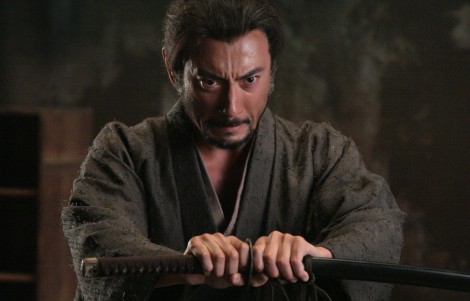
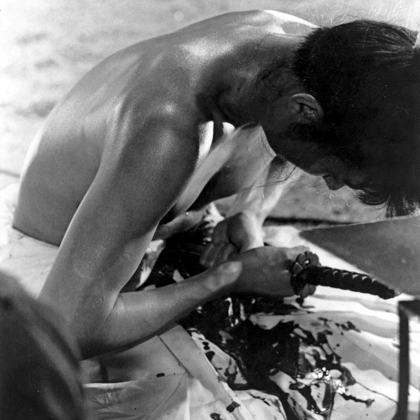
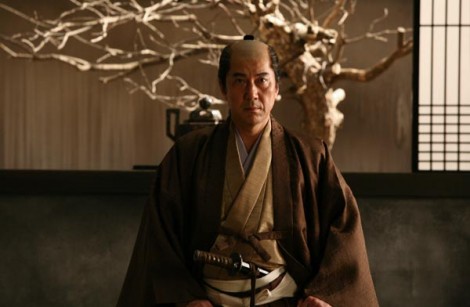
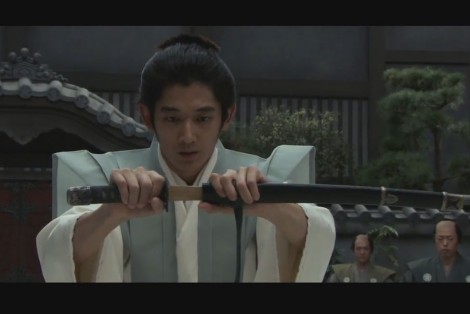
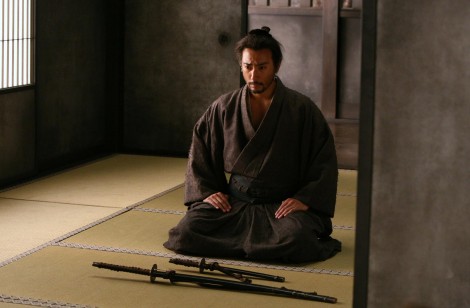
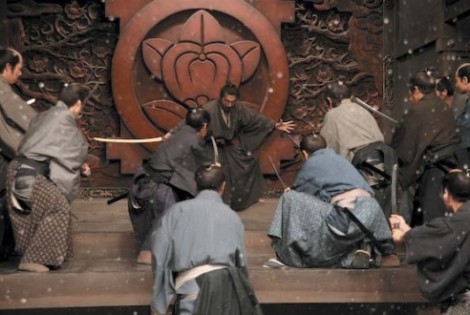
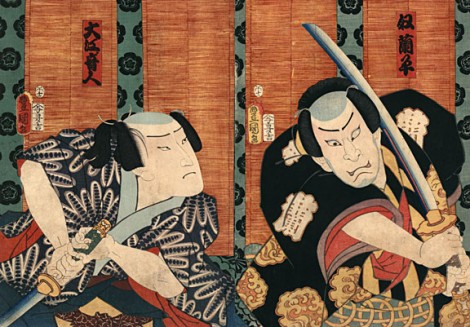




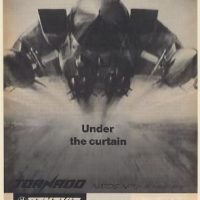


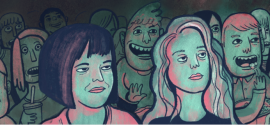

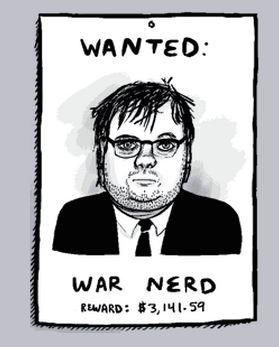
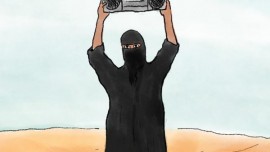
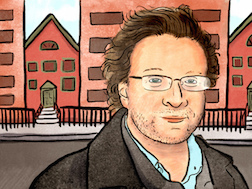
35 Comments
Add your own1. Hiram Bilgewater | September 3rd, 2012 at 10:04 pm
Dearest eXholes,
Do you know the way to San Jose?
”Why are you so angry, my dear son? Can’t you see that your father and I aren’t so angry. Mother, you don’t know what is coming to you and your children and children’s children. A darkness is veiling my child’s smile with its shadow, with the shadow of death and darkness, with infinite greed that insoufflates the UFO pastures of my mind and even the grave of Captain Ahab.”
http://www.youtube.com/watch?v=zsHwVRL06R8
Cheers,
Hiram Bilgewater
2. Trevor | September 4th, 2012 at 5:50 am
I could never get into Miike. He front-loads his films with so much gore that the net affect is kinda dull.
Park Chan-wook, now there’s a guy who knows how to film a mutilation and keep it interesting.
3. Fizban | September 4th, 2012 at 6:43 am
Great article Eileen, glad to see Miike and samurai getting some space on Exiled’s frontpage. After going through Kurosawa’s contribution to Japanese cinema, I think I’m ready to divert myself back to catch these Miike gems I missed. Keep up the good work.
4. Flatulissimo | September 4th, 2012 at 4:41 pm
Bought my tickets last week, going to see it tonight! I’m wasn’t a huge Miike fan before, but 13 Assassins was so good, I am really looking forward to this one.
I think the original Hari-kiri was amazing, and there was no reason at all to remake it, but Miike is so prolific, if he wants to direct some of his voluminous output toward remaking some classic samurai films, that’s fine by me.
5. Zhu Bajie | September 4th, 2012 at 5:29 pm
Next, step up to Chinese movies! Hong Kong ghost and vampire movies have a lot to offer!
6. Dimitri Ratz | September 4th, 2012 at 7:04 pm
I’ve seen this one at home about a month back on Comcast. It was one of those stay at home sick nights, and after my disappointment with 13 Assassins, and pizza delivered hot I decided to watch this movie on my large flat screen TV, best TV resolution, the Korean Samsung detail did not do it justice, if I knew how good it was I would of saved for a trip to the theater. The picture quality is not comparable to 13 Assassins, Hara-Kiri is a masterpiece of untold quality. Like looking back at never ending boredom that passed for 70s movie to today more action moving cinema, the modern action cinema is like 70s boredom compared to this movie, but without the ugliness of including unrelated, out of place, redone stuff. This is his best movie that I’ve seen, the best movie that I seen in my life, and Takeshi has redeemed himself. This movie is like Takeshi slicing his own belly open for the low quality flick 13 Assassins, and I am going to the Theater when his next movie comes out. Also I didn’t expect to have a romantic, in depth movie on this level while embracing swordsmanship. Its like the movie Prometheus, but not defending I’m quality after first few scenes. The depth of storyline would have one think that Tolstoy reincarnated as a Japanese play write. Truly a great movie.
7. Maxim Fermi | September 4th, 2012 at 9:38 pm
gee muthafucks, you’ve convinced me to see this.
also, just wondering if Eileen reviewed Haneke’s The White Ribbon at any stage? I’m guessing it’s not her kind of thing though….
8. Galtic Warrior | September 4th, 2012 at 9:47 pm
Mark Ames, movies are brought to you by CEOs who distribute them across large scales.
YOU have…NO RIGHT…to complain about corporations when you praise their work.
But I digress. Like all of the sheep in the world, you fail to see the insatiable threat your chosen shepherds have led us to.
How do they do this? They don’t go to a film producer and say, “Oh, by the way, we’re Illuminati members and we want you to make a movie that promotes our agenda”. (Remember, they aren’t stupid, either). Instead, they pervert a small investment corporation that funds movies with ideas that they like. They quietly hire actors and producers and directors and scripts, but they never mention their affiliation publicly or why they are doing this.
Money talks, and especially in leftist Hollywood. If you have money, you can get about anything made, and they know this. They can also channel money into advertising campaigns, etc. for their films (how many times have freeloading “minorities” have been the po in the past twenty years? Very few. How many times has a CEO been “the bad guy” I rest my case).
This has been a slow, subtle process because they are patient. They have been working behind the scenes for HUNDREDS of years, and they know that the public is slow to accept new ideas, that it has to be done gradually. And it has been. The number of films demonizing business men that has come out in the past ten years alone should make anyone pause and think.
Soon, all of the money will be stolen from those who have toiled in misery to earn and share it with the public. And none of you care, because the good shepherds have led you to your slaughter!
9. Sakevi | September 4th, 2012 at 11:47 pm
Really? No mention that this is a remake of a classic Japanese film Kobayashi Masaki?
I know Eileen’s last column was about how classic films aren’t really classic. But Seppuku/Harakiri is an exception maybe. Saw this awhile ago in Asia, it’s a pretty straight adaptation of the original, only in color.
Of course it’s not like other ultra-violent Miike.. because it’s not really him.
10. Flatulissimo | September 5th, 2012 at 5:44 am
Okay, so I saw it last night – pretty great.
Unlike 13 Assassins, which had that torso-woman and that blood-splosion and other weirdness-es that gave it away as a Miike flick, this one was played totally straight and close to the vest for the entire two hours.
And yeah, the original is a classic, and this remake really wasn’t particularly necessary, but damn, it sure was good.
Not like this is going to be a huge hit in America, but aside from the whole “honor” thing being so important, which they won’t get, I think Americans today could relate to this movie more than the Japanese. The Japanese have got national health insurance now, after all, while more Americans are living like the characters in this film – hard-working people who can’t afford to go to the damn doctor.
(And was it just me, or did the samurai who was the “second” during the seppuku scene remind you of a Japanese Joe Don Baker?)
11. Margo Adler | September 5th, 2012 at 6:12 am
Good review. Informative and also made me want to throw up, then laugh. Am procuring both versions of the film now.
12. Zhu Bajie | September 5th, 2012 at 6:17 am
@8 Garlic Warrior “(Remember, they aren’t stupid, either).”
They are not smart enough to be afraid of ordinary people.
13. Sas | September 5th, 2012 at 7:23 am
@9
Before Eileen sicks the AEC on you:
“Even if you don’t know the plot of Hara-kiri from the legendary 1962 film version directed by Masaki Kobayashi of the Samurai Trilogy, or the short story, Yasuhiko Takiguchi’s “Ibun Roninki,” the title tells you what you’re in for.
PS: I second #5’s request for reviews of HK cinema classics.
14. CB | September 5th, 2012 at 12:25 pm
“YOU have…NO RIGHT…to complain about corporations when you praise their work. ”
What an interesting point of view!
If I try to view the world as anything other than completely black-and-white — where if an entity has ever done wrong then they cannot possibly have ever done right and vice versa — and actually acknowledge instances of both even if they are in wildly different in circumstance and degree, then by so doing I actually LOSE the right to make such observations?
Which unfortunately means that by observing that your post is well-written and has good spelling and grammar, I’m have lost the right to also observe that the meaning behind those well-written words is bat-shit insane gibberish.
It also means you can’t complain about Ames’ opinions while both consuming the output of his site and using it as the launching board for your own pontifications. Or it would, if self-contradiction had even been a problem for the bat-shit insane.
15. Dimitri Ratz | September 5th, 2012 at 1:18 pm
With all yays counted and no nays I move the motion to have the HK Classics reviewed.
16. Galtic Warrior | September 5th, 2012 at 3:00 pm
Eileen Jones, can I ask you something? How… is someone like me with all this time on my hands to comment, how is it that I don’t contribute a damn thing to the free market? Isn’t the invisible hand going to punish me for being a waste of humanity? I know one hand that’s not going to punish me, and that hand has a dollop of lotion and it’s got my name on it! Mmmph!
17. Sakevi | September 5th, 2012 at 4:25 pm
@ # 13
Yeah, but the entire article seemed like it was crediting the theme of the film to Miike’s genius, when in fact there is nothing especially Miike about it.
18. Cavoyo | September 5th, 2012 at 5:15 pm
@12 Are you sure? For all of OWS’s faults, it scared the fuck out of the establishment. The police were ordered to repress it swiftly and relentlessly.
Also, lol @ Gallic Warrior thinking that this movie was made in Hollywood.
19. Geronimofo | September 5th, 2012 at 11:34 pm
1962: “An Apache warrior who defies U.S. attempts to bring the Indians under control grapples with an array of U.S. soldiers sent to subdue his revolt. Sympathetic scouts seek to bring Geronimo back to the reservation before he is hunted down.” The Apache, played by blue-eyed Chuck Connors, realizes he has no chance of defeating the establishment and seeks atonement with the Kiwanians by committing seppuku with a 5-inch Ginzu Santoku. Unable to find the disemboweling blade, he says fuck it, chugs a case of Bud Lite, gnoshes a little zwieback, and signs on with the Koch bros, who ram a Herrenknecht TBM through him.
20. Sas | September 6th, 2012 at 2:57 am
@17
I… I don’t really know what to tell you. Your complaint was “No mention that this is a remake of a classic Japanese film Kobayashi Masaki?”.
It was mentioned right there at the beginning of the article. It also points out that the film is not typical for Miike.
Now your complaint is that Miike didn’t write the story?
You’d have a point if it was a shot-by-shot remake like the godawful Psycho 1998, but that’s not the case here.
Both the remake and the original use storyline, themes and characters from the novel “Ibun rônin-ki” by Yasuhiko Takiguchi, but focus on different aspects of the story. Both movies are stylistically different interpretations of the same source material.
This is how literary adaptations and remakes work.
21. Anarchy Pony | September 6th, 2012 at 10:07 am
OH COME ON! 8 just has to be a parodying troll! There is no way that fucker is serious!
22. Dimitri Ratz | September 6th, 2012 at 1:30 pm
I respect Galtic Warrior’s right to his religious beliefs.
23. Sakevi | September 7th, 2012 at 3:56 am
@ # 17
Was it really a complaint? Seemed thin on the Kobayashi, lost track that this isn’t a Miike film. It’s all I’m saying. Not tryin’ to argue. Looking back down I see a another small reference to Kobayashi, so I guess I’m satisfied.
24. Galtic Warrior | September 7th, 2012 at 10:48 am
Anarchy Pony, The Illuminati occupied banks have driven the world to economic collapse.
George Bush and Dick Cheney send murderous high school drop outs, and all for oil money.
May I ask, is it that hard to believe that a cabal of oligarchy and military judiciaries would formulate something such as a new world order?
Would you –put it past– your government/business leaders/Israel to carry out 9/11? I mean morally?
25. Zhu Bajie | September 7th, 2012 at 11:56 pm
“Would you –put it past– your government/business leaders/Israel to carry out 9/11? I mean morally?” — Garlic Wartier
I doubt the Bushies were competent to do more than steal an election.
26. Petkov | September 8th, 2012 at 7:04 pm
Eileen is finally taking our advice and watching some foreigner movies. About time. Good for her.
I have watched Miike is not for everyone. Haven’t seen his samurais stuff so I cant comment; the others were just too focused on the gore to be enjoyable for me.
Now let me recommend a few more:
District 9, District 13 (Banlieue 13 1 and 2) and “The Raid: Redemption”.
27. Gallic Businessman | September 9th, 2012 at 2:01 am
I’m afraid I have to back Galtic Warrior on this one. I’m a successful billionaire who recently completed building his fifth living house out of Greek prostitutes, and these last few years I’ve just been kicking back and watching the profits roll in from Japanese extreme cinema. (It’s all those T-shirts for the foot-severing scene in Audition.) Thanks, Hollywood!
28. bulfinch | September 9th, 2012 at 4:30 pm
Just saw this. Thanks, Eileen. I dislike most remakes, (minus the first remake of The Thing), but I think there could not be a better time for this one.
The two white cats as allegory was a subtle touch I don’t see mentioned much…
29. The Gubbler | September 13th, 2012 at 11:41 pm
I might actually watch this one…
It better be at least OK…
I thought Audition was OK, but I mainly credited Ryu Murakami (not to be mistaken for Haruki Murakami) for that.
Although, from the few Miike films I have watched, he has demonstrated a kind or energy and talent or something like that, the only one I found passable was Audition, mostly because it was more or less reserved.
I will probably watch this one sooner or later, and if it sucks…
Meanwhile, I plan to view “Tokyo Decadence” again.
30. The Gubbler | September 14th, 2012 at 1:06 am
I just began watching “Tokyo Decadence” and I had a nagging thought that I didn’t sufficiently separate Ryu from Haruki Murakami…
Well, basically what I wanted to say is Haruki is no good. Even at his best he is no match for any of the characters in Ryu’s novels, let alone qualified (though he may be competent in the most superficial way) to be writing novels and short stories.
In short, Haruki is a charlatan which in itself may not be so bad, but in his case, it is pure fart in the face no-good nonsense that you should be concerned about, terribly concerned.
31. The Gubbler | September 14th, 2012 at 3:35 am
I am also pissed off about the first commenter stealing my Dionne Warwicke thing…
So I suppose I have to come up with something else (and I already have).
So I am going to shoot the breeze here…
Yes that is right, I have posted “Anyone Who Ever Had A Heart” before that wasn’t all speeded up like this version…
http://www.youtube.com/watch?v=40JIwp4l9U8
Anyhow, let me think for minute
The Shirelles – Doomsday (an old favorite of mine)
http://www.youtube.com/watch?v=Kqy4UdJ6h4A
32. The Gubbler | September 14th, 2012 at 3:52 am
The Shirelles – Sha-La-La
http://www.youtube.com/watch?v=BsEHrhiwY8A
33. The Gubbler | September 14th, 2012 at 3:58 am
The Shirelles – March (You’ll Be Sorry)
http://www.youtube.com/watch?v=dz_nbtReobI
34. The Gubbler | September 14th, 2012 at 4:02 am
The Shirelles – I Met Him On A Sunday
http://www.youtube.com/watch?v=E0PMr2X4seI
35. The Gubbler | September 14th, 2012 at 4:08 am
The Shirelles – I Met Him On A Sunday (definitive version)
http://www.youtube.com/watch?v=E0PMr2X4seI
Glad I finally found it… Now I can sleep.
Leave a Comment
(Open to all. Comments can and will be censored at whim and without warning.)
Subscribe to the comments via RSS Feed